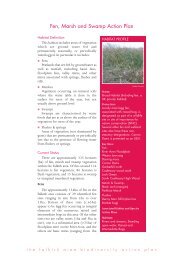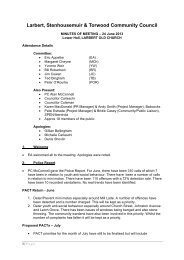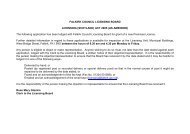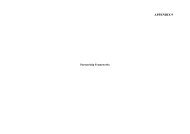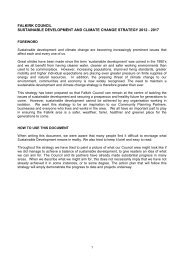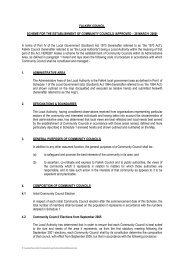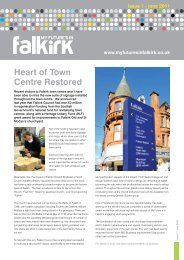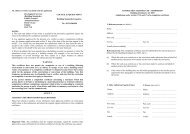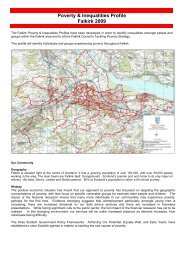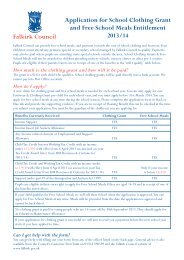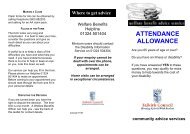2011/2012 audited annual accounts - Falkirk Council
2011/2012 audited annual accounts - Falkirk Council
2011/2012 audited annual accounts - Falkirk Council
Create successful ePaper yourself
Turn your PDF publications into a flip-book with our unique Google optimized e-Paper software.
FALKIRK COUNCIL<br />
Impairment<br />
Assets are assessed at each year-end as to whether there is any indication that an asset may be impaired. Where<br />
indications exist and any possible differences are estimated to be material, the recoverable amount of the asset is<br />
estimated and, where this is less than the carrying amount of the asset, an impairment loss is recognised for the<br />
shortfall.<br />
Where impairment losses are identified, they are accounted for by:<br />
• where there is a balance of revaluation gains for the asset in the revaluation reserve, the carrying amount of<br />
the asset is written down against that balance (up to the amount of the accumulated gains)<br />
• where there is no balance in the revaluation reserve, or an insufficient balance, the excess value is written<br />
down against the relevant service line(s) in the Comprehensive Income & Expenditure Statement.<br />
Where an impairment loss is reversed subsequently, the reversal is credited to the relevant service line(s) in the<br />
Comprehensive Income & Expenditure Statement, up to the amount of the original loss, adjusted for depreciation<br />
that would have been charged if the loss had not been recognised.<br />
Depreciation<br />
Depreciation is provided for on all Property, Plant and Equipment assets by the systematic allocation of their<br />
depreciable amounts over their useful lives. An exception is made for assets without a determinable finite useful<br />
life (i.e. freehold land and certain Community Assets) and assets that are not yet available for use (i.e. assets<br />
under construction).<br />
Depreciation is calculated on the following bases:<br />
• dwellings and other buildings – straight-line allocation over the useful life of the property as estimated by the<br />
valuer<br />
• vehicles, plant, furniture and equipment - a percentage of the value of each class of assets in the Balance<br />
Sheet, as advised by a suitably qualified officer<br />
• infrastructure – straight-line allocation over 25 years<br />
Where an item of Property, Plant and Equipment asset has a valuation in excess of £1.0m and has major<br />
components whose cost is significant in relation to the total cost of the item, the components are depreciated<br />
separately.<br />
Revaluation gains are also depreciated, with an amount equal to the difference between current value<br />
depreciation charged on assets and the depreciation that would have been chargeable based on their historical<br />
cost being transferred each year from the Revaluation Reserve to the Capital Adjustment Account.<br />
Disposals and Non-current Assets Held for Sale<br />
When it becomes probable that the carrying amount of an asset will be recovered principally through a sale<br />
transaction rather than through its continuing use, it is reclassified as an Asset Held for Sale. The asset is<br />
revalued immediately before reclassification and then carried at the lower of this amount and fair value less costs<br />
to sell. Where there is a subsequent decrease to fair value less costs to sell, the loss is posted to the Other<br />
Operating Expenditure line in the Comprehensive Income and Expenditure Statement. Gains in fair value are<br />
recognised only up to the amount of any previous losses recognised in the Surplus or Deficit on Provision of<br />
Services. Depreciation is not charged on Assets Held for Sale.<br />
If assets no longer meet the criteria to be classified as Assets Held for Sale, they are reclassified back to noncurrent<br />
assets and valued at the lower of their carrying amount before they were classified as Held for Sale;<br />
adjusted for depreciation, amortisation or revaluations that would have been recognised had they not been<br />
classified as Held for Sale, and their recoverable amount at the date of the decision not to sell.<br />
Assets that are to be abandoned or scrapped are not reclassified as Assets Held for Sale.<br />
25



